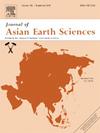Towards resolving the paleoposition of the North China Block at the Carboniferous-Permian boundary: preliminary paleomagnetic results of limestones from the ∼300 Ma Taiyuan Formation, North China.
IF 2.4
3区 地球科学
Q2 GEOSCIENCES, MULTIDISCIPLINARY
引用次数: 0
Abstract
The North China Block (NCB), sandwiched between the Paleo-Tethys and Paleo-Asian Ocean realms, is crucial to the paleogeographic reconstruction of the East Asian blocks in the assembly of the Pangea supercontinent. However, paleoposition of the NCB remains poorly constrained during ∼330–290 Ma, due to difficulties in obtaining reliable paleomagnetic results from the pervasive coal-bearing strata. To solve this puzzle, we find the exclusive targets, several layers of limestones from the Taiyuan Formation in the Xiangning and Lingchuan areas, southern Shanxi Province, and conducted a combined petrographic, rock magnetic, and paleomagnetic study. The dominant magnetic carriers of the Xiangning limestones are magnetite and subordinate pigmentary hematite. The hematite is of secondary origin, while the unoxidized magnetite retains the ability to carry primary remanences. Magnetic carriers of the Lingchuan limestones are magnetite, subordinate hematite, and pyrite. Characteristic remanent magnetizations are isolated from 61 of 99 samples. The newly obtained Lingchuan pole is close to the 120 Ma pole of the NCB, possibly indicating a secondary remagnetization obtained in the Yanshanian Orogeny. The Xiangning pole is located at Plat = 39.9°N, Plong = 340.7°E (A95 = 5.0°, n = 6 samples). Although limited specimens are insufficient to reliably constrain the paleoposition of the NCB, we note the invaluable preliminary pole does not overlap with any younger poles, shedding light on finally resolving the paleoposition of the NCB at the Carboniferous-Permian boundary. Thus, we suggest the Xiangning limestones likely record primary remanences, indicating an equatorial paleolatitude of the NCB.
华北地块石炭-二叠纪界线古对立的解决:华北太原组~ 300 Ma灰岩的古地磁初步结果
华北地块夹在古特提斯洋域和古亚洲洋域之间,对盘古超大陆组装过程中东亚地块的古地理重建具有重要意义。然而,在~ 330-290 Ma期间,由于难以从普遍存在的含煤地层中获得可靠的古地磁结果,NCB的古地磁位置仍然很差。为了解决这一难题,我们找到了独特的目标,即山西南部香宁和陵川地区太原组的几层灰岩,并进行了岩石学、岩石磁学和古地磁的综合研究。香宁灰岩的主要磁性载体为磁铁矿,次要为色素赤铁矿。赤铁矿为次生成因,而未氧化的磁铁矿则保留了原生残留物的携带能力。陵川灰岩的磁性载体为磁铁矿、次级赤铁矿和黄铁矿。从99个样品中分离出61个样品的特征剩余磁化。新获得的凌川磁极接近NCB的120 Ma磁极,可能是燕山造山期获得的二次再磁化。湘宁极位于Plat = 39.9°N, Plong = 340.7°E (A95 = 5.0°,N = 6个样本)。虽然有限的标本不足以可靠地限制NCB的古位置,但我们注意到宝贵的初步极没有与任何较年轻的极重叠,这有助于最终解决NCB在石炭纪-二叠纪边界的古位置。因此,我们认为湘宁灰岩可能记录了原始残留物,表明了北大陆架的赤道古纬度。
本文章由计算机程序翻译,如有差异,请以英文原文为准。
求助全文
约1分钟内获得全文
求助全文
来源期刊

Journal of Asian Earth Sciences
地学-地球科学综合
CiteScore
5.90
自引率
10.00%
发文量
324
审稿时长
71 days
期刊介绍:
Journal of Asian Earth Sciences has an open access mirror journal Journal of Asian Earth Sciences: X, sharing the same aims and scope, editorial team, submission system and rigorous peer review.
The Journal of Asian Earth Sciences is an international interdisciplinary journal devoted to all aspects of research related to the solid Earth Sciences of Asia. The Journal publishes high quality, peer-reviewed scientific papers on the regional geology, tectonics, geochemistry and geophysics of Asia. It will be devoted primarily to research papers but short communications relating to new developments of broad interest, reviews and book reviews will also be included. Papers must have international appeal and should present work of more than local significance.
The scope includes deep processes of the Asian continent and its adjacent oceans; seismology and earthquakes; orogeny, magmatism, metamorphism and volcanism; growth, deformation and destruction of the Asian crust; crust-mantle interaction; evolution of life (early life, biostratigraphy, biogeography and mass-extinction); fluids, fluxes and reservoirs of mineral and energy resources; surface processes (weathering, erosion, transport and deposition of sediments) and resulting geomorphology; and the response of the Earth to global climate change as viewed within the Asian continent and surrounding oceans.
 求助内容:
求助内容: 应助结果提醒方式:
应助结果提醒方式:


